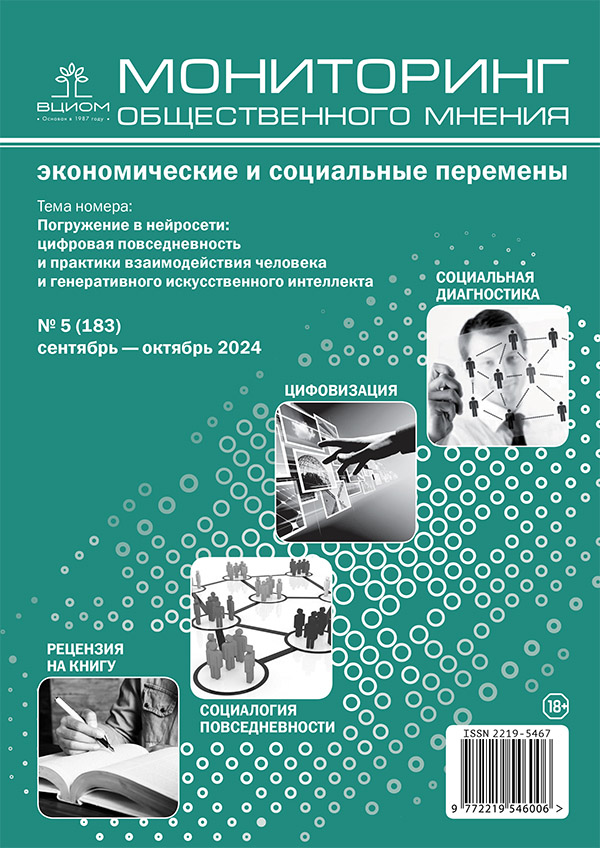Взаимодействие пользователей разного возраста с сервисным роботом: лабораторное исследование
DOI:
https://doi.org/10.14515/monitoring.2024.5.2626Ключевые слова:
взаимодействие человека и робота (HRI), сервисный робот, социальный робот, социальные установки к новым технологиям, агенты коммуникации, адаптация к взаимодействию с роботом , отношение к роботам, изучение пользователейАннотация
Статья посвящена изучению процесса человеко-машинного взаимодействия на примере коммуникации пользователей с сервисным социальным роботом. В теоретико-методологическом плане исследование имеет полипарадигмальную основу: субъективный опыт пользователей и их адаптация к конкретной ситуации взаимодействия с роботом рассматриваются в рамках социального конструктивизма, феноменологии и этнометодологии. Эмпирической базой служит лабораторное исследование с использованием методов социального эксперимента, наблюдения, фокус-групп. Участники эксперимента, имитируя получение стандартной услуги по оформлению документов, обращались к агентам разных типов ― человеку и сервисному роботу в разных режимах работы.
По результатам исследования выделены особенности взаимодействия с сервисным роботом, а также определена специфика субъективного восприятия этого опыта пользователями, относящимися к разным возрастным группам. В ходе работы подтвердилась гипотеза о том, что молодые пользователи легче адаптируются к ситуации взаимодействия с роботом. По оценкам участников исследования, представителям среднего и старшего возраста при получении услуги проще общаться с человеком-консультантом, а молодым участникам ― с роботом (независимо от режима его работы). Также в статье выделены различия в ожиданиях и оценках относительно роботов на уровне общих социальных установок. По результатам фокус-групп, готовность к взаимодействию с роботами снижена по причинам недоверия их функциональным возможностям, неуверенности в собственной компетентности и боязни неопределенности (настороженного отношения ко всему новому).
Благодарность. Авторы выражают благодарность за содействие в проведении исследования сотрудникам кафедры социологии и политологии ПНИПУ Ольге Александровне Ганиной и Юрию Михайловичу Вассерману, а также ООО «Промобот» (г. Пермь).
Библиографические ссылки
Абрамов Р. Н., Катечкина В. М. Социальные аспекты взаимодействия человека и робота: опыт экспериментального исследования // Журнал социологии и социальной антропологии. 2022. Т. 25. № 2. С. 214—243.
Abramov R. N., Katechkina V. M. (2022) Social Aspects of Human-Robot Interaction: Experimental Research Experience. The Journal of Sociology and Social Anthropology. Vol. 25. No. 2. P. 214—243. (In Russ.)
Бергер П., Лукман Т. Социальное конструировании реальности. Трактат по социологии знания. М.: Медиум, 1995.
Berger P., Lukman T. (1995) The Social Construction of Reality. A Treatise in the Sociology of Knowledge. Moscow: Medium. (In Russ.)
Гаврилина Е. А. Агентность не-человеков: взаимодействие людей и социальных роботов // Мониторинг общественного мнения: экономические и социальные перемены. 2023. № 3. С. 41—55. https://doi.org/10.14515/monitoring.2023.3.2318.
Gavrilina E. A. (2023) Agency of Non-humans: Interaction of Humans and Autonomous Intelligent Systems. Monitoring of Pablic Opinion: Economic and Social Changes. No. 3. P. 41—55. https://doi.org/10.14515/monitoring.2023.3.2318. (In Russ.)
Зильберман Н. Н., Стефанцова М. А. Социальный робот: подходы к определению понятия // Современные исследования социальных проблем (электронный научный журнал). 2016. № 11. С. 297—312. https://doi.org/10.12731/2218-7405-2016-11-297-312.
Zilberman N. N., Stefantsova M. A. (2016) Social Robot: Defining the Concept. Modern Research of Social Problem. No. 11. P. 297—312. https://doi.org/10.12731/2218-7405-2016-11-297-312. (In Russ.)
Сачмен Л. Реконфигурации отношений человек — машина: планы и ситуативные действия / пер. с англ. А. С. Максимовой; под ред. А.М. Корбута. М.: Элементарные формы, 2019.
Suchman L. (2019) Plans and Situated Actions: The Problem of Human — Machine Communication. Moscow: Elementary forms. (In Russ.)
Broekens J., Heerink M., Rosendal H. (2009) Assistive Social Robots in Elderly Care: A Review. Gerontechnology. Vol. 8. № 2. P. 94—103.
Gnambs T., Appel M. (2019) Are Robots Becoming Unpopular? Changes in Attitudes Towards Autonomous Robotic Systems in Europe. Computers in Human Behavior. No. 93. P. 53-61. https://doi.org/10.1016/j.chb.2018.11.045.
Hegel F., Muhl C., Wrede B., Hielscher-Fastabend M., Sagerer G. (2009) Understanding Social Robots. In: Second International Conference on Advances in Computer-Human Interaction. Cancun: IEEE. P. 169—174. https://doi.org/10.1109/ACHI.2009.51.
Hudson J., Orviska M., Hunady J. (2017) People’s Attitudes to Robots in Caring for the Elderly. International Journal of Social Robotics. No. 9. P. 199—210. https://doi.org/10.1007/s12369-016-0384-5.
Katz J. E., Halpern D., Crocker E. T. (2015) In the Company of Robots: Views of Acceptability of Robots in Social Settings. In: Vincent J., Taipale S., Sapio B., Lugano G., Fortunati L. (eds.) Social Robots from a Human Perspective. Cham: Springer. P. 24—38. https://doi.org/10.1007/978-3-319-15672-9_3.
Mandl S., Bretschneider M., Asbrock F., Meyer B., Strobel A. (2022) The Social Perception of Robots Scale (SPRS): Developing and Testing a Scale for Successful Interaction Between Humans and Robots. In: Camarinha-Matos L. M., Ortiz A., Boucher X., Osório A. L. (eds.) Collaborative Networks in Digitalization and Society 5.0. PRO-VE. IFIP Advances in Information and Communication Technology. Vol. 662. Cham: Springer. P. 321—334. https://doi.org/10.1007/978-3-031-14844-6_26.
Naneva S., Sarda M., Webb T.L., Prescott T.J. (2020) A Systematic Review of Attitudes, Anxiety, Acceptance and Trust Towards Social Robots. International Journal of Social Robotics. No. 12. P. 1179—1201. https://doi.org/10.1007/s12369-020-00659-4.
Загрузки
Опубликован
Как цитировать
Выпуск
Раздел
Лицензия
Copyright (c) 2024 Мониторинг общественного мнения: экономические и социальные перемены

Это произведение доступно по лицензии Creative Commons «Attribution-NonCommercial-ShareAlike» («Атрибуция — Некоммерческое использование — На тех же условиях») 4.0 Всемирная.






